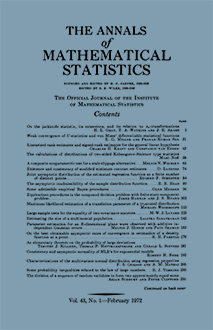Abstract
The multiplicative process is usually defined by the sequence of random variables $X_0, X_1, \cdots$ whose distributions are specified as follows: $P(X_0 = 1) = 1, \sum^\infty_{\nu=0} P(X_1 = \nu) = 1,$ and if $X_n = 0$ then $P(X_{n+1} = 0) = 1,$ whereas if $X_n$ is a positive integer then $X_{n+1}$ is distributed as the sum of $X_n$ independent random variables each with the distribution of $X_1$. The variable $X_n$ is interpreted as the number of "particles" in the $n$th generation, and the index $n$ as a discrete time parameter. This has been the method of approach in previous studies of the process [1, 2, 3, 4, 5]. The multiplicative process has various applications, notably in the study of population growth, the spread of epidemics of rumors, and the nuclear chain reaction. The closely related "birth and death" process was recently studied by Kendall [6]. Whenever one studies the probability theory of a particular system there seem to be definite conceptual advantages in defining explicitly the set $\mathcal{J}$ of elementary events, the additive class $\mathcal{M}$ of subsets of $\mathcal{J}$, called events, and the probability measure $P$ for the events of $\mathcal{M}$. Now an elementary event of this process can be represented by a rooted tree where the original particle is represented by the root vertex and where the particles of the $n$th generation are represented by the vertices $n$ segments removed from the root. The tree will be finite or infinite according to whether a finite or an infinite number of particles are involved in the elementary event. Thus, the set of trees is the natural choice for $\mathcal{J}$. The first part of this paper is devoted to a more precise description of $\mathcal{J, M}$ and $P$. We shall then see easily that $X_n(t)$, the number of vertices $n$ segments removed from the root of $t \epsilon \mathcal{J}$, i.e. the number of particles in the $n$th generation, has the distribution defined in the preceding paragraph. Since the time does not appear in our description of $\mathcal{J}$ we fetter ourselves somewhat if we interpret $n$ as a discrete time parameter. Thus, we have already reaped some harvest from considering the process from the point of view of $\mathcal{J}$. Another advantage is that we are led in a natural way to study the distribution of other structural features of the trees, e.g. the total number of vertices, or the number of vertices with $k$ outgoing segments. The chief results of this paper are as follows. The recursion formula for the probability $P_n$ that a tree have $n$ vertices $n = 1, 2, \cdots$ is obtained as well as an asymptotic estimate of $P_n$ valid for large $n$. The distributions of the number of branches at the root in a finite tree, an infinite tree, or in a tree with $n$ vertices are obtained and the asymptotic distribution of the latter as $n \rightarrow \infty$. The distribution of the fraction of vertices with $k$ outgoing segments in the finite trees, in the trees with $n$ vertices, and the asymptotic distribution of the latter as $n \rightarrow \infty$ are also found. Finally, an estimate is obtained for the probability that a tree be finite in case this probability is near 1, a result which was previously obtained by Kolmogoroff [7].
Citation
Richard Otter. "The Multiplicative Process." Ann. Math. Statist. 20 (2) 206 - 224, June, 1949. https://doi.org/10.1214/aoms/1177730031
Information





